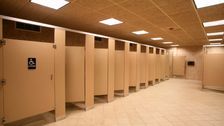When you use a public restroom with multiple stalls in the United States, there will often be at least one accessible stall option wider than the rest.
The Americans With Disabilities Act (ADA) of 1990 was created to ban discrimination against individuals with disabilities in all areas of American public life. And as part of the latest 2010 ADA design guidelines, public and commercial restrooms are required to have at least 5% clustered stalls accommodating people with disabilities.
To be ADA-compliant, these toilet rooms must follow exact measurements for toilet compartment doors, faucets, flush valves, grab bars and soap dispensers, as well as having a floor clearance of 60 inches for turning space.
So when a person without a disability is using that more accessible stall, it can mean less access for the people who can only use that space.
“Stop and think how would you feel if someone compromised your independence simply for their own convenience,” said Dallas, Texas-based wheelchair access advocate Marcela Marañon.
This should not be a controversial stance, but it can be. In 2022, Marañon posted a TikTok skit of her trying to get into an accessible restroom at an airport with a voiceover saying: “Get out. I need to pee.” Marañon said she did it “to show my frustration when I don’t find a handicap accessible toilet available,” and it was meant to highlight how people with invisible and visible disabilities can be prevented from using the more accessible stall. She said she received supportive comments and backlash ― she has now turned the commenting feature off.
“I’ve never received so much hate on social media before,” she said.
Although you can get fined for using an accessible parking space without proper documentation, accessible restroom stalls are not typically reserved for people with disabilities by law in the U.S. Douglas Kruse, co-director of Rutgers University’s Program for Disability Research, said in his experience, it’s more social enforcement than legal enforcement.
“I’ve never encountered any situations where a company or any organization says, ‘You have to avoid using this,’” he said.
But just because it’s not illegal does not mean you should be doing it if you do not need it. Kruse, who uses a wheelchair, said that he doesn’t have a problem when all the other stalls are occupied, and people use the more accessible stall, “but if the others aren’t full, then using the handicapped one is pretty rude.”
In public restrooms, Marañon said that one accessible stall could be her only option to use. That’s why “it’s not OK to be on your phone talking to your friends in the handicap stall, it is not OK to bring two, three friends inside the handicap stall because there is more room, it is not OK to use that as a closet to change your clothes or brush your teeth,” she added.
Using an ADA-accessible stall when you don’t need it can cause problems you aren’t thinking about.
There can be an ableist assumption that using the more accessible stall is not a big deal if you do not have a disability, but it can cause problems for those who need it.
In her 2018 “Living Life With CP” column for Cerebral Palsy News Today, Brittney Clouse wrote that she does not think people who use it “every so often” are the worst, but for chronic users who believe it will be just a minute, her answer is: “No. You shouldn’t.”
“I know that you think you will ‘only be a minute,’” Clouse wrote. “In most public restrooms, I have the option of one toilet, one stall. You have a choice of five. And yes, just like you, we know the struggle — not all accessible stalls are created equal either, just like you may complain about the small size of the regular stalls. Try telling me that on a day when I’m trying to fit my wheelchair into an accessible-marked stall that is two inches too narrow.”
Even when they are technically accessible, these kinds of restrooms can also still not be accessible to people who need them because of a lack of cleanliness, too.
Erin Vallely, who describes herself as a “proud wheelchair user,” said in an essay for the Center for Disability Rights that the lack of fully accessible bathrooms has prevented her from attending “countless things.”
“The toilets often get clogged (because people especially prefer to poop in the accessible stall), and toilet paper is frequently strewn about. If anyone makes a mess or clogs a public bathroom toilet or sink, they need to tell an employee immediately so that it can be taken care of as quickly as possible,” she wrote. “Unless you genuinely need the accessible stall, please do not use it.“
It can also potentially create dangerous medical issues when people are unable to use the restroom when they need it.
“We can get really sick if we don’t go to the toilet on time or we wait for so long. And yeah, I have waited so many times… for other people… And this is why it bothers me,” Marañon said.
Marañon explained that due to waiting for a more accessible stall to open up, “There were so many times where I had to transfer to a non-disabled toilet and pee with the door open. And where is my dignity here?”
Many people have disabilities that are not visible to observers. Don’t judge who uses the accessible stall, either.
You don’t want to assume you know who needs an accessible stall just by looking at them, but unfortunately, many people do.
A survey on behalf of a Crohn’s & Colitis U.K. charity found that half of the people living with Crohn’s disease and colitis ― two main forms of inflammatory bowel disease (IBD) ― said they had faced physical and verbal abuse for using the more accessible toilet option.
As one respondent with Crohn’s put it in the survey: “If people don’t know about Crohn’s or colitis, then it doesn’t matter what you have or what you show as people don’t appreciate why you need to use a clean, private toilet urgently.“
In a polarizing Slate advice column in 1999, the Dear Prudence columnist wrote back to a reader wondering whether it was OK to prefer to use the larger accessible stall when they did not have a disability. In their answer, Prudence affirmed the practice, saying it was one they did as well because “like you, Prudie has never seen a disabled person waiting, though that would not be the end of the world.”
This answer resulted in many letters back to Prudence explaining how they should not make assumptions about who may be waiting, such as this one: “The comment I object to is the one where you say there is never a handicapped person waiting to use it when you are done. There are many conditions that are not visible. I have MS, and look just fine. What is not apparent is that I have a bladder problem and a catheter.”
In reality, most people will either have a disability or know someone with one. One in four people living in the U.S. currently have a disability. That percentage increases to two in five for American adults 65 years and older, according to the Centers for Disease Control and Prevention. You may not need that more accessible stall today, but you could tomorrow.
“We’re all going to have disabilities at some point in our lives,” Kruse said. “Let’s be considerate to those who have disabilities right now.”


